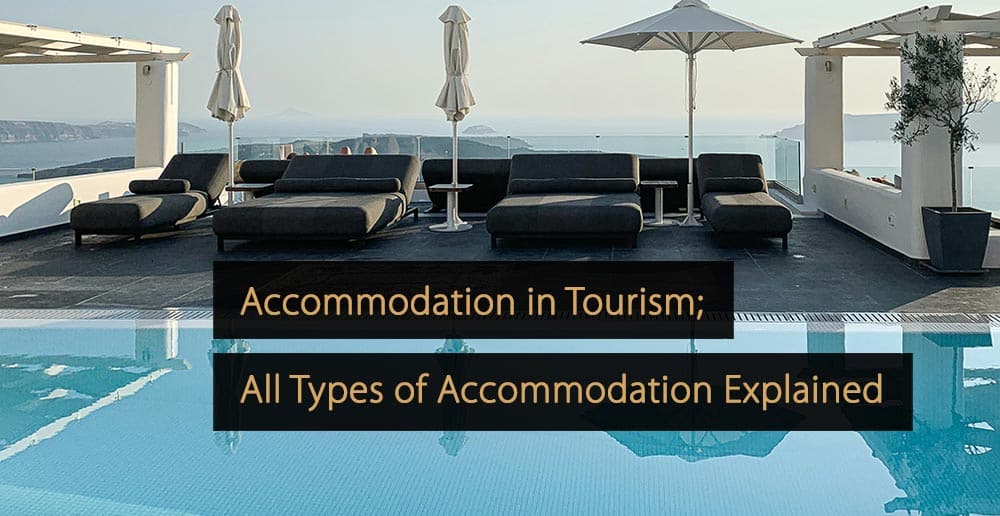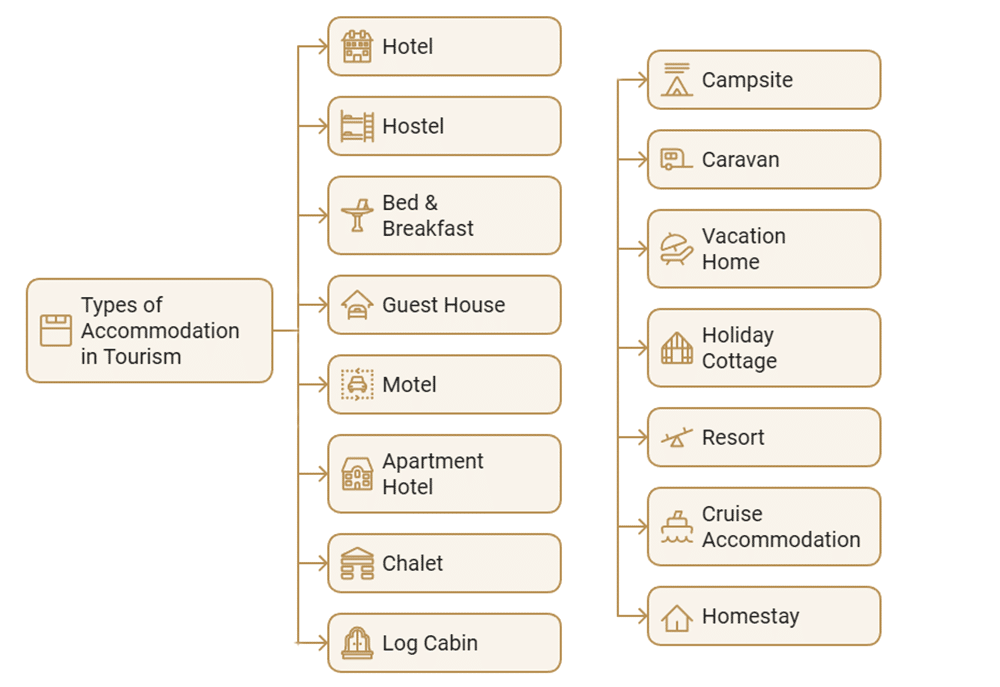Accommodation in tourism refers to various places to stay overnight, which are geared towards tourists. Some of the most common examples include hotels, bed and breakfasts, hostels and resorts.
The role of accommodation is crucial, as people traveling to new locations need a place to sleep. Accommodation businesses play a major part in the overall tourism experience, providing shelter, hospitality, and security.
In this article, you can explore the various types of accommodation in the tourism sector and gain a deeper understanding of how they are defined and what they each have to offer guests.
Table of Contents:
- What is Accommodation in Tourism?
- Types of Accommodation in Tourism
- Understanding the Travel and Tourism Industry
- Exploring the Emerging Concept of Slow Tourism
What is Accommodation in Tourism?
Accommodation in tourism is among the most significant industry sub-sectors and describes the various businesses that provide tourists with somewhere to stay. This typically refers to temporary, overnight lodgings.
Within the tourism industry, accommodation makes it possible for people to visit other locations and access shelter. Accommodation businesses are also often able to provide entertainment and other services.
In the “Accommodation Providers: Strategic Tips to Get More Revenue” article, you can learn much more about the role of accommodation owners, the key types of accommodation, and some of the best tourism marketing strategies.
Types of Accommodation in Tourism
In the sections that follow, you can find out about the main types of accommodation in tourism:
1. Hotel
A hotel is a full-service property, offering overnight stays and related services to customers. Hotels will provide guests with a room and may also include other services, like a restaurant and leisure facilities.
Hotels function as a key component of the travel industry and are a very popular form of accommodation in tourism circles. They offer amenities and services that provide a comfortable and enjoyable stay.
In the “Hotel Industry: Everything You Need to Know About Hotels!” article, you can explore the topic of hotels in greater depth, learn about the role of the hotel industry, and read about hotel star ratings.
2. Hostel
A hostel is an affordable accommodation type which is primarily targeting backpackers and budget-conscious travelers. Hostels typically have shared living spaces and travelers will often rent a bed, not a room.
Hostels are an important form of accommodation in tourism because they offer a basic place to stay for a low price. Hostels are popular with younger travelers, and the shared spaces can offer social benefits.
In the “What Is a Hostel? A Full Hostel Guide for Hoteliers” article, you will be able to find out much more about the features of hostels and explore the various different hostel types.
3. Bed & Breakfast
A bed & breakfast, or B&B, is a small property, typically resembling a guest house, where guests pay for accommodation and a meal in the morning. B&Bs are often family-owned, and guests are given private rooms.
B&Bs are especially important as a form of accommodation in tourism locations away from urban centers. They serve as a middle ground between self-catering holiday cottages and the customer service offered in hotels.
In some cases, the owners of bed & breakfasts will live in the property, or nearby. Additionally, B&Bs tend to have a very limited number of rooms for guests and are often located in villages, small towns or rural areas.
Video: 17 Benefits of Owning a Bed and Breakfast
4. Guest House
A guest house can be seen to be providing a hotel-like experience on a significantly smaller scale. It may be similar to a bed & breakfast, but there is no guarantee of a morning meal with the price.
Guest houses are a valuable form of accommodation in tourism because they are often situated in areas with limited options for lodging. This means they may provide one of the only ways for tourists to visit certain places.
In many instances, guest houses are family-owned. One of the major distinctions between a guest house and a hotel is the fact that guest houses may only have a few full-time employees, and these may be limited to the owners.
5. Motel
A motel is a type of accommodation designed to cater to the needs of motorists. It is similar to a hotel, but individual rooms are accessible from the parking area, and the on-site facilities are more basic.
Motels are typically situated on major travel routes, making them important for travelers who need a place to stay during a longer journey. They are also a more budget-friendly option than most hotels.
In the “Motel Meaning: Understanding the Role of Motels in the Industry” article, you can find out more about how motels are defined, what they can offer guests, and how they function as a type of accommodation in tourism.
6. Apartment Hotel
An apartment hotel is similar to a conventional hotel, but guests are allocated an apartment instead of a room. This typically means the bedroom will be separate from the living space and kitchen facilities are provided.
Apartment hotels play an important role when it comes to accommodation in tourism because they often offer a greater degree of comfort. Apartments are also better suited to situations where guests want to stay for several weeks.
The rise of the apartment hotel is one of the more interesting tourism trends. One of the reasons demand for this type of accommodation is growing is because it can be ideal for digital nomads and corporate travelers.
7. Chalet
A chalet is a wooden building with a sloped roof, which is usually provided to guests on a self-catering basis. The chalet concept is most commonly associated with skiing trips, but chalets can now be found in other locations too.
Chalets are an important type of accommodation in tourism hotspots during the winter months, especially for destinations offering winter sports. However, beach chalets are also growing in popularity.
The chalet concept itself is primarily associated with Switzerland and surrounding European countries, but has made its way to other parts of the world, including North America.
What is the difference between a cabin and a chalet?
8. Log Cabin
Log cabins are huts or small houses, made from wood and often offered to guests with a minimalist interior. As the name suggests, these cabins are primarily constructed from either whole or split logs.
Log cabins are often situated in rural locations or natural environments. This can significantly boost the local economy and encourage tourists to travel to areas that may otherwise be difficult to visit.
Traditional log cabins will often prioritize relaxation and escapism and may be less reliant on technology than many other forms of accommodation in tourism. Log cabins can vary significantly in size.
9. Campsite
A campsite is a location where guests can go camping, typically using a tent. This allows tourists to enjoy the outdoors, experience a sense of community with other campers and/or stay in a location on a limited budget.
Campsites are important because they provide a safe location for campers to visit. They often provide vital amenities like electricity and water and this can make camping accessible to more people.
One of the emerging concepts related to accommodation in tourism is glamping, which is glamorous camping. This typically involves the provision of luxurious tents and more facilities than a standard campsite.
10. Caravan
A caravan is a vehicle that has been adapted for use as accommodation in tourism. Individuals may own the caravan themselves or rent a caravan from a caravan park, and caravans can be either mobile or stationary.
Renting a caravan is a budget-friendly option, suitable for families, couples, groups and solo travelers. Guests that have a caravan of their own can use it to travel almost anywhere and have access to shelter.
Caravans are compact, but offer common household facilities, like beds and cooking facilities.
11. Vacation Home
A vacation home is a house or similar property that is temporarily rented out to guests. It provides a “home away from home” experience and may be more affordable than alternative accommodation in tourism, such as hotels.
Vacation homes are a popular form of accommodation in tourism settings because they provide familiar comforts. They are especially well-suited to families and other tourists who would prefer to cater for themselves.
In most cases, the owner will rent out the entire house for an agreed period of time. Vacation homes may lack some tourism technology solutions, but they usually provide household technology and kitchen facilities.
12. Holiday Cottage
A holiday cottage is similar in principle to a vacation home, but is typically a smaller property. This kind of accommodation in tourism will generally provide excellent comfort at an affordable price point.
Holiday cottages are important for experiential tourism. They can provide a more authentic and traditional experience than modern service-based accommodation, which is usually cheaper than a vacation home.
In some locations, holiday cottages are also marketed as an ecotourism option. These properties may limit technology to reduce energy consumption or may even use renewable energy sources.
13. Resort
A resort is a large-scale form of accommodation in tourism, which serves as a destination in its own right. It is similar to a large hotel, but will have everything guests need on-site, including shops and entertainment.
The role of resorts within the tourism industry is important because they can single-handedly attract visitors to a location. This means they can play a valuable role in tourism management and marketing.
While resorts can be considered destinations on their own, many are also located near major attractions, such as theme parks. Resorts often have very high service standards and will prioritize the guest experience.
14. Cruise Accommodation
Cruise accommodation describes a form of floating accommodation, with guests staying aboard a cruise ship. Unlike most other forms of accommodation in tourism, cruises do not have a fixed location.
A cruise ship is a unique form of accommodation, catering to a specific type of tourist. Cruises will often appeal to couples, older travelers, or people with specific niche interests that are served by the cruise.
The cruise ship will usually have a destination or multiple destinations, where guests can leave the ship. Facilities onboard the ship usually include beds, restaurants, bars, and onboard entertainment.
15. Homestay
A homestay is a type of accommodation offered by a local individual or family to people they do not personally know. It can include situations where guests stay with the property owner, or rent the accommodation from them.
Homestays are one of the most significant forms of accommodation in tourism today, owing to the rise of platforms like Airbnb. These platforms allow private citizens to make money by offering their property to strangers.
The homestay experience can vary wildly, from unique forms of accommodation, to standard residential properties.
Understanding the Travel and Tourism Industry
In addition to exploring accommodation in tourism, it is worth taking time to truly understand travel and tourism as a whole. This is a diverse industry, which includes everything from lodgings and transportation to restaurants, entertainment venues, and tourist information centers.
In the “Travel and Tourism Industry; A Complete Overview of All Activities” article, you can read a definition of travel and tourism, and also explore the different business types in the sector.
Exploring the Emerging Concept of Slow Tourism
Slow tourism is a term used to describe travel experiences that focus on local experiences and cultural exploration, rather than cramming stereotypical travel experiences into a short stay. It has been devised as an option to counterbalance some of the harms associated with mass tourism.
In the “Slow Tourism: What It Is, Its Importance, and Examples” article, you can examine the concept of slow tourism in far greater detail and gain an understanding of what slow tourism advocates want to achieve.
Did You Like This Article about Accommodation in Tourism?
You might also be interested in the following articles:
- Types of Accommodation in the Hotel Industry
- Accommodation Service Providers: Successful Tips for More Revenue
- Accommodation Providers: Strategic Tips to Get More Revenue
- The Differences between Hotels and Service Apartments Explained
- Exploring the Difference Between a Hotel and Resort: Key Industry Insights
- Differences Between a Hotel and a Motel Clearly Explained
Accommodation in tourism comes in many different forms, catering to the needs of different types of travelers. From budget-friendly hostels to the most luxurious 5-star luxury resorts, these businesses all have a role to play in facilitating travel, boosting local economies, and providing jobs.
More Tips to Grow Your Business
Revfine.com is the leading knowledge platform for the hospitality and travel industry. Professionals use our insights, strategies, and actionable tips to get inspired, optimize revenue, innovate processes, and improve customer experience.Explore expert advice on management, marketing, revenue management, operations, software, and technology in our dedicated Hotel, Hospitality, and Travel & Tourism categories.
This article is written by:
Hi, I am Martijn Barten, founder of Revfine.com. With 20 years of experience in the hospitality industry, I specialize in optimizing revenue by combining revenue management with marketing strategies. I have successfully developed, implemented, and managed revenue management and marketing strategies for individual properties and multi-property portfolios.










Leave A Comment